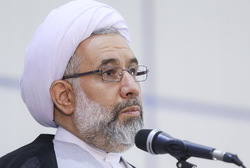 Rasa – Hujjat al-Islam Abbasi said, “The Persian language is the means of the transmission of spirituality, rationality and the message of the Islamic Revolution.”
Rasa – Hujjat al-Islam Abbasi said, “The Persian language is the means of the transmission of spirituality, rationality and the message of the Islamic Revolution.” RNA – The fifth gathering of institutes active in the teaching of the Persian language in the world was held by the Sa’di Foundation at Imam Khomeyni Specialized University in Qom.
Hujjat al-Islam Dr. Ali Abbasi, the newly-appointed dean of al-Mustafa International University, said that today, the domain of Persian language is unique to several countries in the region and said, “Iran, Afghanistan, Tajikistan and parts of Uzbekistan speak Persian, while about two centuries ago, this language predominated in the sub-continent and Central Asia.”
His Eminence added that before the Russians began their domination over Central Asia, many people spoke Persian and it was even spoken in the territory of the Ottoman Empire and some Persian-language books in these areas demonstrate this claim.
He continued, “Even today, in parts of northern China, the Golestan of the poet Sa’di, and Persian language and literature are promoted as well. Based on the ranking of languages on the total number of speakers, the Persian language is the fifteenth most spoken language in the world and while it’s dynamic, it enjoys stability that is less seen in other languages.”
Expressing that in more than a thousand years, the Persian language has been associated with Islamic and religious scholarship, Hujjat al-Islam Abbasi stated, “The Persian language is a means for the transfer of religious knowledge and teachings as a second language and from the very first centuries, the writing of religious knowledge in became popular in Persian.”
In another part of his speech, the member of the Council for the Advancement of the Humanities stated, “Later, many Quranic interpretations were written in Persian and this language was considered a great language in order to introduce the Islamic world. In Iran, besides being the official language, the Persian language was also constantly an academic language. This same issue, along with the assistance that language academies have performed to adapt the language to the scientific concepts of today, Persian has been transformed into a strong language in the field of the transmission of knowledge.”
He emphasized that the two factors play a role in the development of language, saying, “One is scientific and technological advancement, and the second is the element of culture and knowledge. The Persian language has both of these elements. Thanks to the Islamic Revolution and according to the findings from the centres of knowledge, scientific growth and development in the Persian language is six percent of the world’s scientific production, while the proportion in Arabic is two percent.”
Hujjat al-Islam Abbasi said, “The Persian language is the language of the transfer of the spirituality of rationality and justice – meaning the message of the Islamic Revolution. Various institutions have been formed to teach the Persian language to non-Persian speaking people. al-Mustafa International University, based on its own mission, which is to train religious scholars, has established Persian as a prerequisite of further education.”
112/974